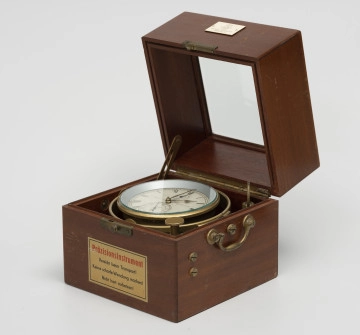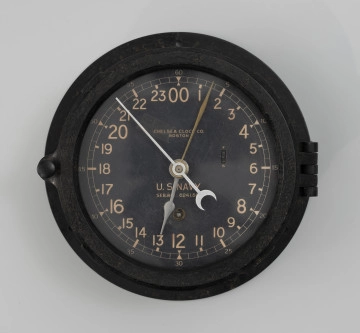
Chronometer mounted on Cardan's suspension.
1901 — 1950
National Museum in Szczecin
Part of the collection: Navigation history
A significant problem for sailors in the 18th century was determining the longitude of a ship at a particular time. While latitude was relatively simple to calculate based on the position of the North Star or the Sun above the horizon, the latitude at which a ship was located was calculated by means of dead reckoning, which was based on determining the distance travelled by a vessel from its last observed position, using a covered course and speed. However, positions defined in this manner did not take into account wind directions and sea currents. One solution would have been to calculate longitude based on the difference in time between noon at Greenwich, through which the 0° meridian runs and the locally determined solar noon. However, for this method to yield tangible results, a very accurate timepiece was needed. The first clock with a measurement error of fewer than 2 minutes, equivalent to half a degree of longitude in navigation, was built in 1759 by John Harrison (1693-1776). With variations of one second per month, its chronometer allowed for a very accurate determination of longitude at sea. The featured timepiece was manufactured by the Soviet First Moscow Watch Factory (Первый Московский часовой завод) established in 1930, which had been named after Sergei Mironovich Kirov (1886-1934) since 1935. The piece pre-dates the quartz era, in which the seconds hand advances in half-second increments and the spring pull theoretically permits a 56-hour movement. In practice, however, the chronometer was wound every 24 hours. It required 8 and a half counterclockwise turns at the same time every day. To control the possible measurement error of the device, the reading was compared with the radio signal from Greenwich every day, and the data was recorded in the chronometer logbook. Leszek Kocela
Author / creator
Object type
chronometer
Technique
batch production
Material
wood, metal, colourless glass
Origin / acquisition method
purchase
Creation time / dating
Creation / finding place
Owner
Muzeum Narodowe Szczecin
Identification number
Location / status

Glashütter Uhrenbetrieb GmbH (1845- )
1901 — 1950
National Museum in Szczecin

Chelsea Clock Company (1897- )
1941 — 1945
National Museum in Szczecin

Glashütter Uhrenbetrieb GmbH (1845- )
1955 — 1970
National Museum in Szczecin
DISCOVER this TOPIC
Castle Museum in Łańcut
DISCOVER this PATH
Educational path
0/500

We use cookies to make it easier for you to use our website and for statistical purposes. You can manage cookies by changing the settings of your web browser. More information in the Privacy Policy.
We use cookies to make it easier for you to use our website and for statistical purposes. You can manage cookies by changing the settings of your web browser. More information in the Privacy Policy.
Manage cookies:
This type of cookies is necessary for the website to function. You can change your browser settings to block them, but then the website will not work properly.
WYMAGANE
They are used to measure user engagement and generate statistics about the website to better understand how it is used. If you block this type of cookies, we will not be able to collect information about the use of the website and we will not be able to monitor its performance.